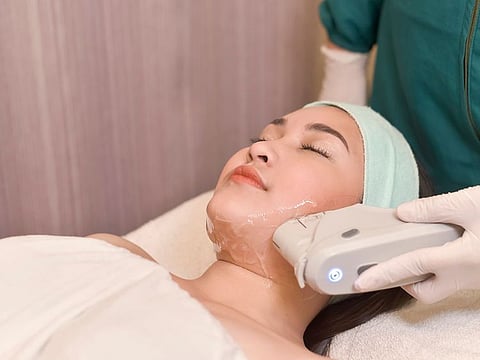Forget the scalpel: The future of non-invasive beauty is here
The results are consistent and come with a good margin of safety

Highlight
As technology advances, non-invasive aesthetic procedures are offering safer and more effective alternatives to traditional surgery
In a world obsessed with looking good without breaking a sweat, the needle and laser have officially dethroned the scalpel. Non-invasive aesthetic procedures are taking the beauty industry by storm, offering effective solutions for those who want to combat aging without going under the knife. But what's behind this beauty revolution?
Dr Deepti Bandekar, General Practitioner in Dermatology and Cosmetology at Aster Clinic, Fujairah, highlights the convenience and safety of these treatments. "Multiplatform Radiofrequency (RF) has proven very effective for treating various skin concerns like fine lines, tightening, and sagging. The results are consistent and come with a good margin of safety," she says.
The Fractional and Pixel Mode of laser delivery can treat fine to medium wrinkles and age-related blemishes. These methods provide precision without the invasiveness of traditional surgery.

RF therapy, in particular, uses energy to heat the deeper layers of the skin, stimulating collagen and elastin production. "This helps tighten and firm the skin, reducing the appearance of wrinkles and sagging. RF treatments are suitable for various skin types and require no downtime," Dr Mohamed notes.
The advancements in laser therapies are also noteworthy. "The Fractional and Pixel Mode of laser delivery can treat fine to medium wrinkles and age-related blemishes. These methods provide precision without the invasiveness of traditional surgery," Dr Bandekar explains. She adds that combining Platelet-Rich Plasma (PRP) procedures with non-invasive treatments boosts hydration and collagen stimulation, enhancing the overall results and reducing side effects.
Dr Nelly Mohamed, a Specialist in Dermatology at Tajmeel Clinic in Dubai, emphasises the rapid evolution in aesthetic dermatology. "Radiofrequency (RF), microcurrent, and laser therapies are at the forefront of non-surgical anti-aging treatments. These technologies offer natural-looking results with minimal downtime," she believes.
Microcurrent therapy uses low-level electrical currents to stimulate facial muscles and enhance cellular activity. It boosts ATP (adenosine triphosphate) production, which is crucial for cellular repair and rejuvenation. The result is improved skin tone, reduced fine lines, and a more youthful appearance.

Laser treatments, such as fractional lasers and intense pulsed light (IPL), target specific skin issues with precision. "These therapies can improve skin texture, reduce pigmentation, and stimulate collagen production. The versatility of laser treatments allows for customisation based on individual skin concerns and goals," Dr Mohamed explains.
Microcurrent therapy is another game-changer. "This technology uses low-level electrical currents to stimulate facial muscles and enhance cellular activity. It boosts ATP (adenosine triphosphate) production, which is crucial for cellular repair and rejuvenation. The result is improved skin tone, reduced fine lines, and a more youthful appearance," she says.
Aging affects all layers of the face—skin, underlying fat, muscles, and bone. Technologies like micro-focused ultrasound (HIFU) and deeper microneedling radio frequencies can target deeper tissue layers, addressing wrinkles, sunspots, and photoaging.

RF therapy is a standout for its safety and effectiveness. "Available in forms such as bipolar and multipolar RF, these non-invasive options gradually stimulate collagen to improve skin sagging. By elevating skin temperatures beyond 43-45 degrees Celsius, they induce protein denaturation and collagen stimulation," Dr Mukherjee explains.
Dr Mansi Mukherjee, Dermatologist and Head of Medical, Kaya Skin Clinic, delves into the comprehensive approach to combating aging. "Aging affects all layers of the face—skin, underlying fat, muscles, and bone. Technologies like micro-focused ultrasound (HIFU) and deeper microneedling radio frequencies can target deeper tissue layers, addressing wrinkles, sunspots, and photoaging," she says.
Innovations like M phase technology uniquely target facial muscles, which thin and atrophy with age. "By toning these muscles and combining with RF, these technologies enhance skin tightening," she says. Modern devices often integrate multiple therapies into single platforms, allowing simultaneous treatment of different skin layers for comprehensive results.
The consensus among experts is clear: non-invasive aesthetic treatments provide a compelling alternative to traditional surgery, with fewer risks and quicker recovery times. So, if you're looking to turn back the clock without the hassle, it might be time to embrace the power of the needle and laser.
Less downtime
Dr Bandekar highlights the appeal of non-invasive treatments. "These treatments address most age-related concerns like wrinkles, uneven skin tone, and blemishes with much less downtime and significantly higher safety, leading to greater patient satisfaction," she says. Traditional surgical procedures, on the other hand, often come with higher risks of pigmentation, scarring, and extended recovery periods.
Dr Mohamed, agrees, emphasising the minimal downtime associated with non-invasive treatments like radiofrequency (RF) and laser therapies. "While surgical facelifts and other invasive procedures can require weeks of recovery, non-surgical treatments typically involve little to no downtime," she explains. "RF and microcurrents usually cause mild redness or swelling, which subsides within a few hours to a day, allowing clients to resume their daily activities almost immediately."
For laser therapies, the intensity of the treatment might cause temporary redness, swelling, or peeling. However, Dr Mohamed notes that "the recovery time is significantly shorter than surgical options, often just a few days. Overall, non-invasive treatments offer a safer and more convenient alternative with fewer risks and quicker recovery times."
Dr Mukherjee acknowledges that non-invasive treatments may be slower in producing results compared to surgical options, but they come with significantly shorter downtimes. "One concern I've often heard from patients considering surgery is the fear of waking up dissatisfied with the results. Additionally, surgical procedures require repetition over time, unlike non-invasive therapies," she explains.
Dr Mukherjee also points out that while surgery can achieve a level of tightening that non-surgical methods may not fully match, it involves longer downtimes, ranging from one to three months for complete recovery. Many individuals initially try energy-based devices before opting for surgery, and even after surgery, continuing with low-energy treatments is often necessary due to ongoing collagen loss.
"Traditional facelifts now incorporate advanced techniques like NanoFat injections and volumising to address changes in facial volume," she says. "Starting energy-based treatments early, around the age of collagen decline (typically after 25), can act as 'skin insurance,' enhancing the extracellular matrix and preventing premature aging."
Combining energy-based devices with injectables forms a bridge between completely non-invasive and surgical approaches. "Injectables like hyaluronic acid, poly lactic acid, and calcium hydroxyapatite stimulate collagen gradually over months, complementing treatments tailored to individual needs and ages," Dr Mukherjee explains.
For younger patients, non-ablative lasers with zero downtime offer immediate skin improvement with gradual enhancement. "In contrast, microneedling radiofrequency and ablative lasers deliver deeper energy, requiring about five to seven days of recovery, occasionally up to two weeks for extensive treatments," she says. Modern devices minimise post-treatment effects like redness, allowing quick makeup coverage and faster skin regeneration.
Dr Bandekar, explains that treatments like radiofrequency (RF) and microstimulation are suitable for almost all skin types, including younger patients. "These options are mostly suitable for all skin types and even for younger clientele because of their larger safety margin and manageable post-procedure care," she says. However, non-ablative lasers tend to be more effective for lighter skin types (1-3) and should be used with caution on darker skin (Type 4) due to the risk of post-inflammatory hyperpigmentation.
Who can benefit?
Dr Mohamed believes non-invasive anti-aging treatments are ideal for a broad range of patients. "Ideal candidates include those looking for gradual, natural-looking enhancements rather than dramatic changes. Individuals with busy lifestyles who cannot afford extended recovery periods benefit greatly from non-invasive options, as well as clients with early signs of aging who are not ready for surgery," she claims. These treatments can be effective across various skin types and conditions, but a thorough consultation with a dermatologist is essential to determine the most appropriate approach.
Dr Mukherjee highlights the differences in how various skin types age and respond to treatments. "Every skin type ages differently," she says. "For instance, Type 1, Type 2, and Type 3 skin—typically Caucasian or lighter skin tones—tend to develop wrinkles more quickly due to thinner skin, though they have strong bone structure and are prone to sun exposure." In contrast, Type 4 and Type 5 skin, such as Indian skin, is thicker and less prone to wrinkles but may experience faster sagging due to less structural support. This skin type often benefits from treatments targeting pigmentation and skin texture.
For Type 6 skin, which includes African skin types known for their thickness, oiliness, and melanin-rich complexion, treatments focus more on managing pigmentation issues. Dr Mukherjee advises using gentle approaches to avoid excessive pigmentation response to treatments like ablative lasers. "Lighter non-ablative lasers and cautious use of microneedling radiofrequency are typically preferred in such cases," she adds.
Regarding the use of lasers, Dr Mukherjee emphasises the importance of adjusting parameters based on skin type. "It's crucial to adjust settings like fluence and pulse width based on the skin type. For instance, I might use the same laser on both darker and lighter skin types, but I must modify the settings. When using a pigment laser, I need to be cautious with stronger settings on pigmented skin to avoid adverse effects," she explains.
Dr Mukherjee further elaborates on the need for personalised treatment approaches. "There are effective devices tailored for each skin type. For example, micro-focused ultrasound (HIFU) and M phase microneedling radiofrequency are particularly beneficial for Type 4 and Type 5 skin, addressing both sagging and pigmentation concerns. These devices are versatile and suitable for use across different skin types, ensuring personalised treatment approaches to meet individual needs effectively."
With technology advancing at breakneck speed, the future of beauty treatments is brighter than ever. Dr Bandekar believes that the evolution of technology will make treatments more simplified, acceptable, affordable, and safer for patients. "I see Platelet Rich Plasma and Fibrin as great emerging biologic options before performing these non-invasive procedures whenever possible, leading to better results and much lesser side effects," she says.
Future advancements
Dr Mohamed highlights several promising technologies on the horizon. "High-intensity focused ultrasound (HIFU) is emerging as a powerful tool for non-surgical skin tightening and lifting, targeting deeper skin layers and promoting collagen renewal," she explains. Nanotechnology is also showing potential in delivering active ingredients more effectively through skincare products and treatments. "Regenerative medicine techniques such as platelet-rich plasma (PRP) therapy and stem cell treatments are gaining traction for their ability to promote skin rejuvenation and repair from within," Dr Mohamed adds.
The future is also leaning towards highly personalised treatments. "Advances in genetic testing and AI-driven diagnostics are paving the way for highly personalised treatment plans tailored to individual skin types and aging patterns," Dr Mohamed claims. As these technologies evolve, we can expect even more effective and versatile non-invasive treatments, providing patients with an array of options to achieve youthful skin without the need for surgery.
Dr Mukherjee sees a continuous influx of new devices every year. "The trend seems to be toward increasingly minimally invasive treatments with minimal downtime," she believes. A significant area of development is in drug delivery. "Imagine performing a non-invasive treatment that delivers active ingredients directly into deeper skin layers. For instance, using tranexamic acid serum for pigmentation or condition media for aging skin could yield rapid and effective results," she elaborates.
Cryotherapy is also emerging, focusing on cold therapy for drug delivery without downtime, contrasting with traditional heat-based methods. "Skin tightening remains a major focus, with advancements in ultrasound technology aiming to deliver energy precisely to targeted depths without affecting the skin's surface," Dr Mukherjee notes. Linear ultrasound, for example, combines with injectables to enhance results.
In terms of injectables, peptides and other well-researched substances are enhancing the effects of non-invasive treatments. "There's even an FDA-approved laser specifically for acne treatment, offering an alternative to oral medications like Accutane," she says. This advancement is particularly promising for patients seeking life-changing improvements in acne and acne scars.
The rapid evolution of laser technology, including new wavelengths and techniques that minimize damage and invasiveness, underscores the field's ongoing progress. "The future lies in integrating these innovations seamlessly to maximise treatment efficacy while minimising discomfort and recovery time," Dr Mukherjee says.
Sign up for the Daily Briefing
Get the latest news and updates straight to your inbox








